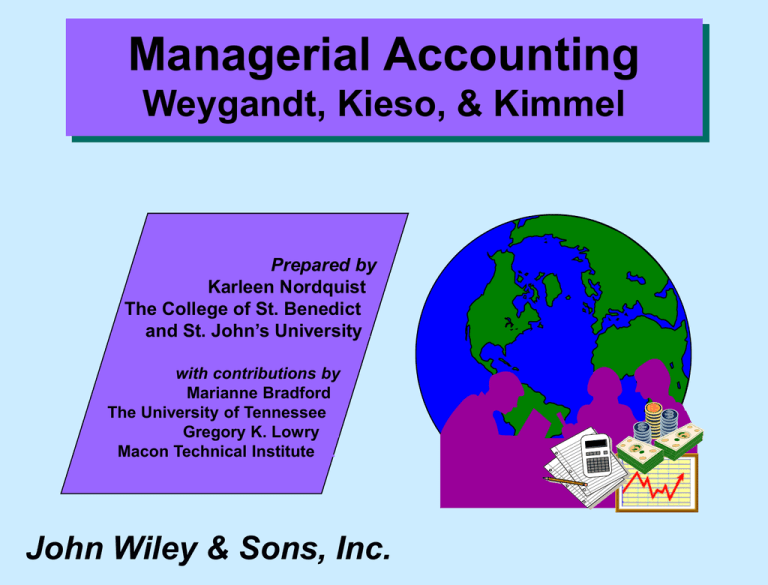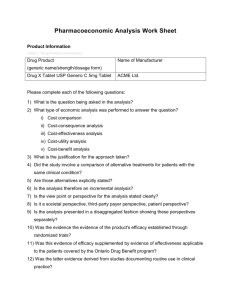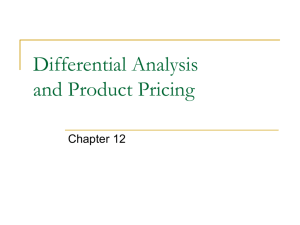
Managerial Accounting
Weygandt, Kieso, & Kimmel
Prepared by
Karleen Nordquist..
The College of St. Benedict...
and St. John’s University...
with contributions by
Marianne Bradford..
The University of Tennessee...
Gregory K. Lowry….
Macon Technical Institute…..
John Wiley & Sons, Inc.
Chapter 9
Incremental Analysis
Chapter 9
Incremental Analysis
After studying this chapter, you should be able to:
1 Identify the steps in management’s decision-making
process.
2 Describe the concept of incremental analysis.
3 Identify the relevant costs in accepting an order at a
special price.
4 Indicate the relevant costs in a make-or-buy decision.
5 Give the decision rule in deciding whether to sell or
process materials further.
Chapter 9
Incremental Analysis
After studying this chapter, you should be able to:
6 Identify the factors to be considered in retaining or
replacing equipment.
7 Explain the factors that are relevant in deciding
whether to eliminate an unprofitable segment.
8 Explain the term “sales mix” and its effects in
determining break-even sales.
9 Determine sales mix when a company has limited
resources.
Preview of Chapter 9
Decision-Making Process
• Incremental Analysis Approach
• How Incremental Analysis
Works
Types of Incremental Analysis
INCREMENTAL
ANALYSIS
• Accept an Order at a Special
Price
• Make or Buy
• Sell or Process Further
• Retain or Replace Equipment
• Eliminate an Unprofitable
Segment
Preview of Chapter 9
Sales Mix
• Break-even Sales
• Limited Resources
INCREMENTAL
ANALYSIS
Other Considerations
• Qualitative Factors
• Incremental Analysis and ABC
Study Objective 1
Identify the steps in management’s
decision-making process.
Management’s DecisionMaking Process
Management’s decision-making process
frequently involves the following steps:
1 Identify the problem and assign responsibility.
2 Determine and evaluate possible courses of
action.
3 Make a decision.
4 Review results of the decision.
Management’s DecisionMaking Process
In making decisions, management ordinarily
considers both financial and nonfinancial
information.
Although nonfinancial information can be as
important as, and in some cases more important
than, financial information, the following
discussion will primarily be limited to financial
information that is relevant to decisions since
that is the kind of information accounting usually
provides (primarily in steps 2 and 4).
Study Objective 2
Describe the concept of
incremental analysis.
Incremental Analysis
Business decisions involve a choice among alternative
courses of action.
The process used to identify the financial data that change
under alternative courses of action is called incremental
analysis.
In some cases, both costs and revenues will change under
alternative choices. In other cases only costs or revenues will
vary.
It is important to recognize that
– variable costs may not change under the alternatives, and
– fixed costs may change.
Incremental Analysis
Incremental analysis involves not only
identifying relevant revenues and costs, but
also determining the probable effects of
decisions on future earnings.
Data for incremental analysis often involves
estimates and uncertainty.
Gathering data may involve market analysts,
engineers, and accountants.
How Incremental Analysis
Works
The basic approach in incremental analysis is illustrated
in the following illustration:
Revenues
Costs
Net income
Alternative
A
$125,000
100,000
$ 25,000
Alternative
B
$110,000
80,000
$ 30,000
Net Income
Increase (Decrease)
$(15,000)
20,000
$ 5,000
Illustration 9-2
In this illustration, alternative B is being compared with
alternative A. The net income column shows the
differences between the alternatives. Alternative B will
produce $5,000 more net income than alternative A.
Key Cost Concepts in
Incremental Analysis
Three important cost concepts used in incremental
analysis follow:
In incremental analysis, the only factors to be
considered are those costs and revenues that differ
across alternatives. Those factors are called
relevant. Costs and revenues that do not differ
across alternatives can be ignored when trying to
chose between alternatives.
Key Cost Concepts in
Incremental Analysis
Often in choosing one course of action, the company
must give up the opportunity to benefit from some
other course of action. This lost benefit is referred to
as opportunity cost.
Costs that have already been incurred and will not be
changed or avoided by any future decision are
referred to as sunk costs. Sunk costs are not relevant
costs.
Types of Incremental
Analysis
A number of different types of decisions involve
incremental analysis. The more common types of
decisions are whether to:
Accept an order at a special price.
Make or buy component parts or finished
products.
Sell products or process them further.
Retain or replace equipment.
Eliminate an unprofitable business segment.
Study Objective 3
Identify the relevant costs in
accepting an order at a special price.
Accept an Order at a
Special Price
Sometimes a company may have an opportunity to obtain
additional business if it is willing to make major price
concessions to a specific customer.
An order at a special price should be accepted when the
incremental revenue from the order exceeds the incremental
costs.
It is assumed that sales in other markets will not be affected
by the special order. If other sales were affected, the lost
sales would have to be considered in making the decision.
If the units can be produced within existing plant capacity,
generally only variable costs will be affected.
Accept an Order at a
Special Price
To illustrate, assume that Sunbelt Company
produces 100,000 automatic blenders per
month, which is 80% of plant capacity.
Variable manufacturing costs are $8 per
unit, and fixed manufacturing costs are
$400,000, or $4 per unit. The blenders are
normally sold to retailers at $20 each.
Question:
Sunbelt has an offer from Mexico Co.
to purchase an additional 2,000
blenders at $11 per unit. Acceptance
of this offer would not affect normal
sales of the product, and the
additional units can be manufactured
without increasing plant capacity.
Accept an Order at a
Special Price: Incremental Analysis
If management makes its decision on the basis of total cost per unit of
$12 ($8 + $4), the order would be rejected, because costs ($12) would
exceed revenues ($11) by $1 per unit. However, since the units can be
produced within existing plant capacity, the special order will not
increase fixed costs. The relevant data for the decision, therefore, are the
variable manufacturing costs per unit of $8 and the expected revenue of
$11 per unit.
Revenues
Costs
Net income
Reject
Order
$ -0-0$ -0-
Accept
Order
$22,000
16,000
$ 6,000
Net Income
Increase (Decrease)
$ 22,000
(16,000)
$ 6,000
Illustration 9-4
Decision:
Sunbelt will increase its net income by $6,000 when accepting this
special order.
Study Objective 4
Indicate the relevant costs in a
make-or-buy decision.
Make or Buy
When a manufacturer assembles component parts
in producing a finished product, management must
decide whether to make or buy the components.
This is often referred to as an outsourcing
decision.
If there is an opportunity to use the productive
capacity for another purpose, opportunity costs
should be considered.
The decision to make or buy components should be
made on the basis of incremental analysis.
Make or Buy
Assume that Baron Co. incurs the following
annual costs in producing 25,000 ignition
switches for motor scooters.
Direct materials
Direct labor
Variable manufacturing overhead
Fixed manufacturing overhead
Total manufacturing costs
Total cost per unit ($225,000 25,000)
$ 50,000
75,000
40,000
60,000
$225,000
$9.00
Alternatively, Baron may purchase the
ignition switches from Ignition, Inc., at
a price of $8 per unit.
Question:
Should Baron make or buy the
ignition switches?
Make or Buy:
Incremental Analysis
At first glance, it appears that management should buy the switches for
$8 instead of make for $9. However, a review of operations indicates that
if the switches are purchased all of Baron’s variable costs, but only
$10,000 of its fixed manufacturing costs, will be eliminated. Thus,
$50,000 of fixed costs will remain. The incremental costs are:
Illustration 9-6
Direct materials
Direct labor
Variable manufacturing costs
Fixed manufacturing costs
Purchase price
Total annual cost
Make
Buy
$ 50,000 $ - 0 75,000
-040,000
-060,000
50,000
-0200,000
$225,000 $250,000
Net Income
Increase (Decrease)
$ 50,000
75,000
40,000
10,000
(200,000)
$ (25,000)
Decision:
Barton Company will incur $25,000 of additional costs by buying the
switches. Therefore, Barton should continue to make the switches.
Make or Buy with Opportunity
Cost: Incremental Analysis
Assume that through buying the switches, Baron Co. can use the
released productive capacity to generate additional income of
$28,000. This lost income is an additional cost of continuing to
make the switches in the make-or-buy decision. This opportunity
cost is added to the “Make” column, for comparison.
Illustration 9-7
Total annual cost
Opportunity cost
Total cost
Make
Buy
$225,000 $250,000
28,000
-0$225,000 $250,000
Net Income
Increase (Decrease)
$(25,000)
28,000
$ 3,000
Decision:
It is now advantageous to buy the switches. Barton will save $3,000
worth of costs with this alternative.
Study Objective 5
Give the decision rule in deciding
whether to sell or process
materials further.
Sell or Process Further
Many manufacturers have the option of selling
products at a given point in the production cycle or
continuing to process with the expectation of selling
them at a higher price.
The sell-or-process further decision should be
made on the basis of incremental analysis.
The basic decision rule in a sell or process further
decision is: Process further as long as the
incremental revenue from such processing
exceeds the incremental processing costs.
Sell or Process Further
Assume that Woodmasters, Inc. makes tables.
The cost to manufacture an unfinished table is
$35, computed as follows:
Direct materials
Direct labor
Variable manufacturing overhead
Fixed manufacturing overhead
Total manufacturing costs
$ 15
10
6
4
$35
The selling price per unfinished unit is $50.
Woodmasters currently has unused productive
capacity that is expected to continue indefinitely and
can be used to finish the tables and sell them for $60
each. For a finished table direct materials and direct
labor costs will increase $2 and $4, respectively.
Variable overhead will increase by $2.40 (60% of direct
labor). There will be no increase in fixed overhead.
Question: Should Woodmasters sell the
unfinished tables or process them further?
Sell-or Process Further:
Incremental Analysis
The incremental analysis on a per unit basis is as follows:
Illustration 9-9
Sales per unit
Cost per unit
Direct materials
Direct labor
Variable manufacturing overhead
Fixed manufacturing overhead
Total
Net income per unit
Sell
$50.00
Process
Further
$60.00
15.00
10.00
6.00
4.00
$35.00
$15.00
17.00
14.00
8.40
4.00
$43.40
$16.60
Net Income
Increase (Decrease)
$10.00
(2.00)
(4.00)
(2.40)
-0$(8.40)
$ 1.60
Decision:
It would be advantageous for Woodmasters to process the tables
further. In this case, the per unit incremental revenue of $10.00 from
the additional processing is $1.60 higher than the per unit incremental
processing costs of $8.40.
Study Objective 6
Identify the factors to be considered
in retaining or replacing equipment.
Retain or Replace
Equipment
Management often has to decide whether to continue
using an asset or replace it.
In a decision to retain or replace equipment,
management compares the costs which are affected
by the two alternatives. Generally, these are variable
manufacturing costs and the cost of the new
equipment.
The book value of the old machine is a sunk cost
which is a cost that cannot be changed by any present
or future decision. Sunk costs are not relevant in
incremental analysis.
Any trade-in allowance or cash disposal value of the
existing asset is relevant, however.
Retain or Replace
Equipment
Assume that Jeffcoat Company has a
factory machine with a book value of
$40,000 and a remaining useful life of four
years. A new machine is available that costs
$120,000 and is expected to have zero
salvage value at the end of its 4-year useful
life. If the new machine is acquired, variable
manufacturing costs are expected to
decrease from $160,000 to $125,000 annually
and the old unit will be scrapped.
Question:
Should Jeffcoat Company
retain or replace the machine?
Retain or Replace:
Incremental Analysis
The incremental analysis for the 4-year period is as follows:
Variable manufacturing costs
New machine cost
Total
Retain
$640,000a
$640,000
Replace
$500,000b
120,000
$620,000
Net Income
Increase (Decrease)
$140,000
(120,000)
$ 20,000
a(4
years x $160,000)
b(4 years x $125,000)
Illustration 9-10
Decision:
In this case, it would be to the company’s advantage to replace the
equipment. The lower variable manufacturing costs due to
replacement more than offset the cost of the new equipment.
Study Objective 7
Explain the factors that are relevant
in deciding whether to eliminate an
unprofitable segment.
Eliminate an Unprofitable
Segment
Management sometimes needs to decide whether to
eliminate an unprofitable business segment.
Again, the key is to focus on the data that change under
the alternative courses of action.
Often fixed costs allocated to the unprofitable segment
must be absorbed by the other segments. It is possible,
therefore, for net income to decrease when an
unprofitable segment is eliminated.
In deciding whether to eliminate an unprofitable
segment, management should choose the alternative
which results in the highest net income for the company
as a whole.
Eliminate an Unprofitable
Segment
Assume that Martina Company manufactures
tennis racquets in three models: Pro, Master,
and Champ. Pro and Master are profitable
lines, whereas Champ operates at a loss.
Condensed income statement data are:
Sales
Variable expenses
Contribution margin
Fixed expenses
Net income
Pro
$800,000
520,000
280,000
80,000
$200,000
Master
$300,000
210,000
90,000
50,000
$ 40,000
Champ
$100,000
90,000
10,000
30,000
$(20,000)
Total
$1,200,000
820,000
380,000
160,000
$ 220,000
Question:
Should the Champ segment be eliminated?
Eliminate an Unprofitable
Segment
Although it appears that income would increase if the
Champ line was discontinued, it is possible for income
to decrease if Champ was discontinued. The reason is
that the fixed expense allocated to Champ will have to be
absorbed by the other products. To illustrate, assume
that the $30,000 of fixed costs are allocated 2/3 to Pro
and 1/3 to Master. The revised income statement data is:
Sales
Variable expenses
Contribution margin
Fixed expenses
Net income
Pro
$800,000
520,000
280,000
100,000
$200,000
Master
Total
$300,000 $1,100,000
210,000
730,000
90,000
370,000
60,000
160,000
$ 40,000 $ 210,000
Decision: Total net income has decreased $10,000 ($220,000 – $210,000).
Unprofitable Segment:
Incremental Analysis
This result is also obtained in the following incremental
analysis:
Illustration 9-13
Sales
Variable expenses
Contribution margin
Fixed expenses
Net income
Continue
$100,000
90,000
10,000
30,000
$(20,000)
Eliminate
$ -0-0-030,000
$ 30,000)
Net Income
Increase (Decrease
$(100,000)
90,000
(10,000)
-0$ (10,000)
Decision:
Once again, total net income has decreased $10,000 ($220,000 –
$210,000). This corresponds to the Champ segment’s contribution
margin. Thus, management should not discontinue the Champ
segment unless other lines can recover some or all of the
sales/contribution margin lost by the discontinued segment.
Study Objective 8
Explain the term “sales mix” and its
effects in determining break-even sales.
Sales Mix
One of the assumptions of CVP analysis
(discussed in Chapter 5) is that if more than one
product is involved, the sales mix of the
products remains constant.
Sales mix is the relative combination in which a
company’s products are sold.
For example, if 4 chairs are sold with each table,
the sales mix of chairs to tables is 4:1.
Break-Even Sales
Break-even sales can be computed for a mix of two or
more products by determining the weighted average
unit contribution margin of all the products.
To illustrate, assume that Vargo Video sells both VCRs
and TVs at the following per unit data:
Unit Data
Selling price
Variable costs
Contribution margin
Sales mix
VCRs
$500
300
$200
TVs
$800
400
$400
3
1
Illustration 9-14
Break-Even Sales
The total contribution margin for the sales mix
of 3 VCRs to 1 TV is $1,000, computed as
follows:
[($200 x 3) + ($400 x 1)] = $1,000
The weighted average unit contribution
margin, which is total CM divided by the
number of units in the sales mix is $250,
computed as follows:
$1,000/4 units = $250
Break-Even Formula:
Sales Mix
Then use the weighted average unit contribution
margin to compute break-even sales as follows:
Assume Vargo Video has $200,000 of fixed costs.
Fixed Costs
$200,000
Weighted
Average Unit
Contribution
Margin
=
Break-even Point
in Units
$250
=
800 units
Break-Even Sales
Note that with a sales mix of 3:1, ¾ of the units sold will be
VCRs and ¼ will be TVs. Therefore, in order to break even,
Vargo Video must sell 600 VCRs (¾ x 800) and 200 TVs (¼
x 800). This can be verified by the following:
Product
VCRs
TVs
Unit Sales
600
200
800
x
x
x
Unit CM
$200
400
=
=
=
Total CM
$120,000
80,000
$200,000
Illustration 9-16
Management should continually review the company’s
sales mix. At any level of units sold, net income will
be greater if more high CM units are sold than low
CM units.
Study Objective 9
Determine sales mix when a
company has limited resources.
Limited Resources
When a company has limited resources (floor space, raw
materials, or machine hours), management must decide
which products to make and sell in order to maximize net
income.
In an allocation of limited resources decision, it is necessary
to find the contribution margin per unit of limited
resource.
This is obtained by dividing the contribution margin per unit
of each product by the number of units of the limited
resource required for each product.
Production should be geared to the product with the highest
contribution margin per unit of limited resource.
Limited Resources
Assume that Collins Co. manufactures deluxe
and standard pen and pencil sets. The limited
resource is machine capacity, which is 3,600
hours per month. Relevant data consists of:
Contribution margin per unit
Machine hours required per unit
Deluxe
$8
.4
Question:
Should Collins Co. shift its sales mix
toward deluxe or standard sets?
Standard
$6
.2
Limited Resources
Based on the previous data, it might appear that deluxe
is more profitable since they have a higher contribution
margin. However, standard sets take fewer machine
hours. Therefore, it is necessary to find the contribution
margin per unit of limited resource, as shown below:
Contribution margin per unit (a)
Machine hours required per unit (b)
Contribution margin per unit of
limited resource (a b)
Deluxe
$8
.4
Standard
$6
.2
$20
$30
Decision: Since the standard set has
the higher contribution margin per
unit of limited resource, sales mix
should shift towards that product.
Limited Resources:
Incremental Analysis
This result is confirmed by the following incremental analysis:
Illustration 9-19
Machine hours (a)
Contribution margin per unit of
limited resource (b)
Contribution margin (a x b)
If Produce
Deluxe Sets
600
$20
$12,000
If Produce
Standard Sets
600
$30
$18,000
Decision:
Once again, it is clear that standard sets produce more contribution
margin. Thus, given adequate demand for standard sets, the sales
mix should shift to that product in order to maximize Collins
Company’s income.
Other Considerations in
Decision Making
In this chapter, the focus was primarily
on the quantitative (those attributes
that can be easily expressed in terms of
numbers) factors that affect a decision.
Many of the decisions involving
incremental analysis have important
qualitative features that, while not
easily measured, should not be
ignored.
Other Considerations in
Decision Making
It was noted in Chapter 4 that many
companies have shifted to activitybased costing (ABC) to allocate
overhead costs to products.
The concepts presented in this chapter
are completely consistent with the use
of ABC. In fact, ABC will result in
better identification of relevant costs,
and therefore, better incremental
analysis.
Copyright
Copyright © 1999 John Wiley & Sons, Inc. All rights reserved.
Reproduction or translation of this work beyond that named in
Section 117 of the 1976 United States Copyright Act without the
express written permission of the copyright owner is unlawful.
Request for further information should be addressed to the
Permissions Department, John Wiley & Sons, Inc. The purchaser
may make back-up copies for his/her own use only and not for
distribution or resale. The Publisher assumes no responsibility for
errors, omissions, or damages, caused by the use of these programs
or from the use of the information contained herein.
Chapter 9
Incremental Analysis





